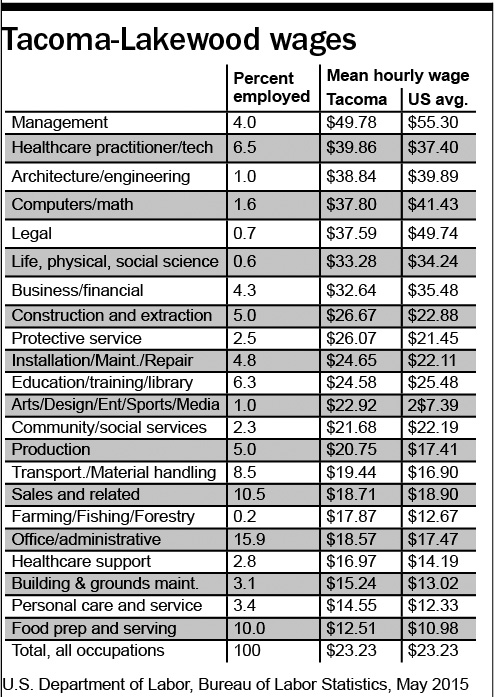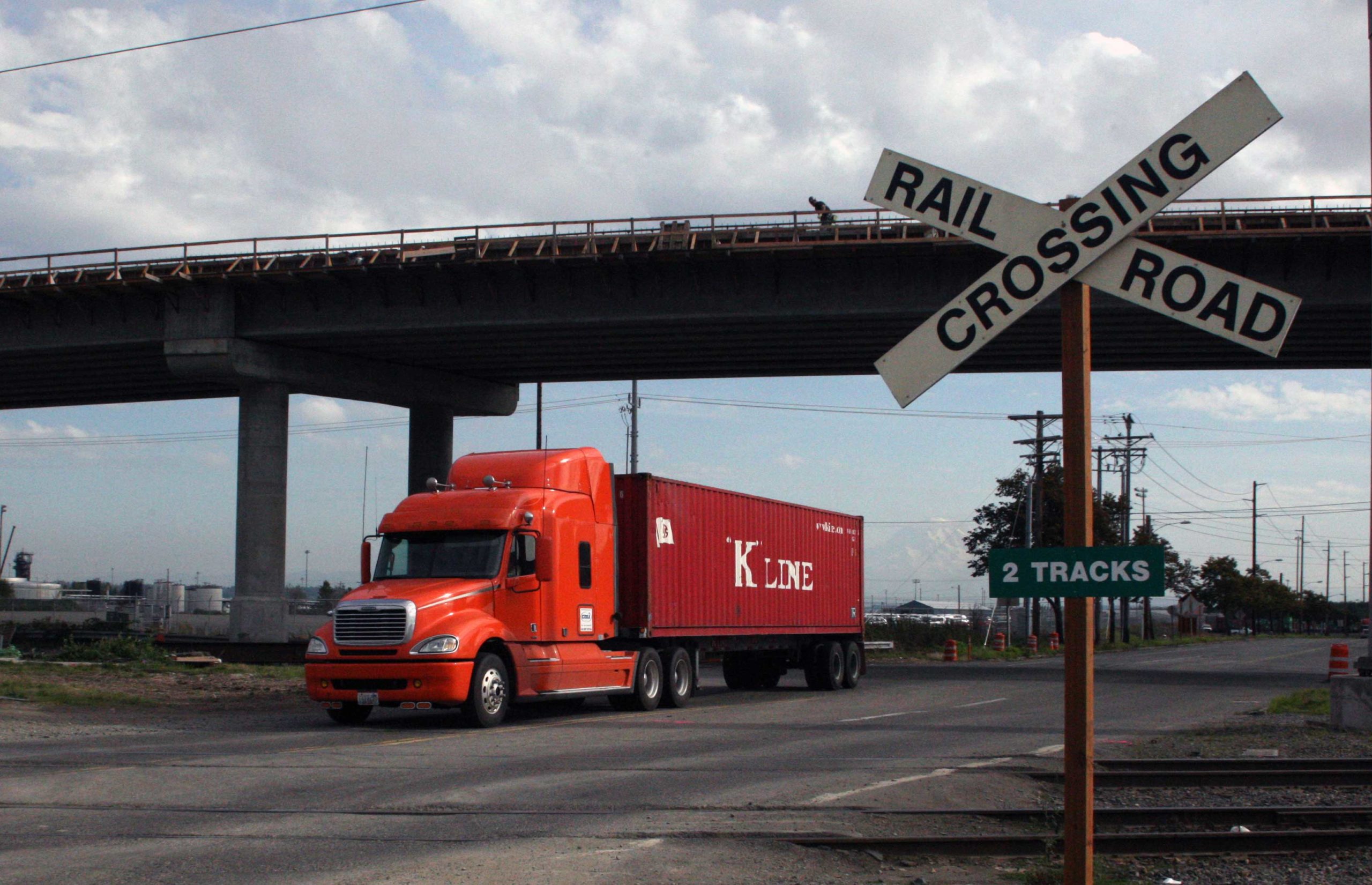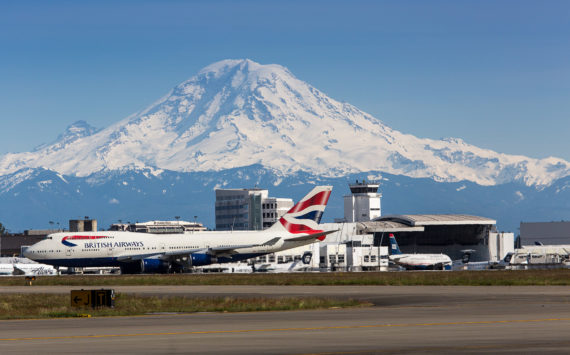Workers in Tacoma area average $23.23 an hour; minimum wage hike heads to ballot
By David Guest
Tacoma Daily Index editor
The United States Bureau of Labor Statistics released a report this month that found the average hourly wage in the Tacoma-Lakewood metropolitan area in May 2015 was $23.23 per hour, equalling the national average for all workers. But that bit of news isn’t necessarily good for everyone.
Nearly 55 percent of all workers in the Tacoma area earned less than $20 per hour, with those in the food preparation and service industry at the bottom (10 percent of the workforce) earning $12.51 an hour on average, including tips. Factoring in the higher cost of living in the area than the national average, Tacoma-area workers are faring worse than their counterparts nationally.
The Council for Community and Economic Research, which factors housing, groceries, health care, transportation, utilities and other expenses into its cost of living index, found that the cost of living in Tacoma was 3.8 percent above the national average in the first quarter of the year. Residing in Seattle will cost you more than 49 percent of the national average.
The numbers provide ammunition for legislators, labor and citizens groups to push for an increase in the state minimum wage, which is currently $9.47 an hour, although higher in municipalities like Tacoma, Sea-Tac and Seattle. Initiative 1433, likely to be on the ballot this fall, will raise the state minimum wage to $13.50 per hour ($28,080 annually) by 2020, and mandate employer-paid sick leave.
“We know that even $13.50 per hour is not enough for many workers to meet basic needs for housing, health care, food, transportation and other basic needs,” said Jeff Johnson, President of the Washington State Labor Council, AFL-CIO. “But we also know that we have to start accelerating minimum wage increases in a way that allows employers to adapt – while also benefitting from higher consumer demand in their local economies.”
But even if I-1433 passes, is $13.50 an hour enough for an individual to live on? Maybe.
A 2015 study by Dr. Amy Glasmeier at the Massachusetts Institute of Technology, calculated the “living wage” for a single adult in Pierce County at $22,404 per year, or $10.77 an hour for full-time work (40 hours a week) before taxes. The typical expenses used in the living wage calculation included food, housing, transportation, taxes, medical and minor miscellaneous expenses.
However, when factoring medical expenses ($1,845 per year), the study assumed the employee would have access to employer-paid (full or partial) health insurance. According to the U.S. Census Bureau, only 55.4 percent of workers in private industry received employer-based health insurance in 2014.
Through government-subsidized “Obamacare” programs, an individual earning the MIT living wage ($10.77/hour, 40 hours/week) can find a zero-premium health plan according to Washington Health Plan Finder. But free isn’t free. Those low-cost health insurance plans come with (for example) a $4,500 deductible that must be met before insurance will begin to pay out, and will then pay 80 percent of medical costs until a $6,500 out-of-pocket maximum is reached. And while in a medical crisis, $6,500 is a bargain, it’s still $4,655 more than the budget for health care that the MIT living wage prescribes.
Families near the living wage income line fare a little better than singles as subsidies further reduce health insurance deductibles in most cases, but Glasmeier points out in her study that having just one child pushes the living wage in Pierce County for a single parent to $49,914 per year, or $24 per hour, above the average wage for all Pierce County workers according to the BLS. Two working adults with three children need a household income of $78,000 annually to make ends meet, according to Glasmeier.
In 2015, Tacoma voters approved a measure that requires employers in the city limits to increase the minimum wage to $10.35 an hour, which will rise to $12 an hour in 2018. The Washington State minimum wage, which is tied to the consumer price index, is $9.47.
The Tacoma Daily Index calculated the living wage differently than MIT. The MIT study viewed rent, medical expenses, taxes and other costs much less conservatively than the TDI.
The Index set a more realistic living wage at $14.73 an hour, or around $30,000 per year before taxes for a single adult (see “Living wage” chart, below).
How many workers in Washington State actually earn minimum wage? According to the BLS, it’s just 1 percent of the total workforce. Minimum wage earners are mostly young, white and live with their parents. The 16-to-24-year-old demographic makes up half of all minimum wage workers – 77 percent are white and nearly half are white women. So, if the vast majority of workers in the state are earning above the MIT living wage, why raise the minimum wage?
“Many studies have shown that raising the floor on wages benefits both the workers at or near the bottom and the businesses where they spend their higher wages,” Jeff Johnson said. “I-1433 offers a choice between continuing down the low road with poverty wages, or taking the high road to shared prosperity.
Not all agree.
“Our board was overwhelmingly concerned over the cost of Initiative 1433 and how it would impact job retention and growth, particularly for young adults who are in minimum wage jobs,” Association of Washington Businesses President Kris Johnson said.
“The minimum wage should be a starting point. Quickly and arbitrarily raising it to $13.50 per hour could have unintended consequences, including driving some industries out of the state and removing an important rung on the ladder for those seeking to enter the workforce.”











